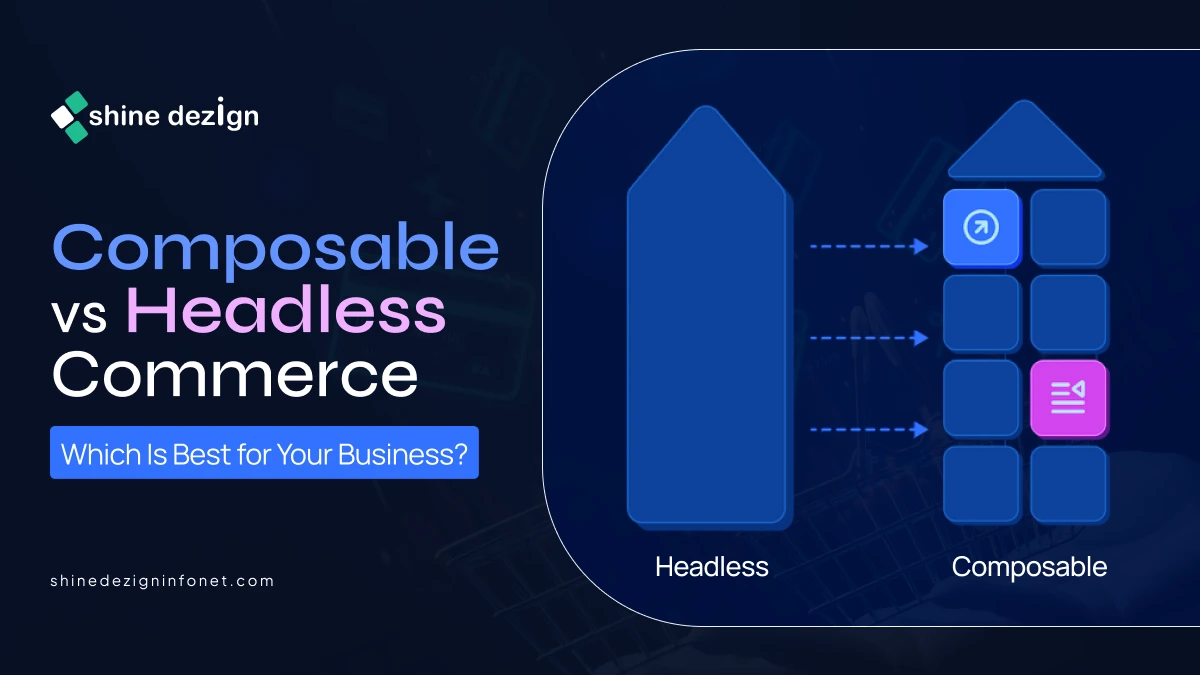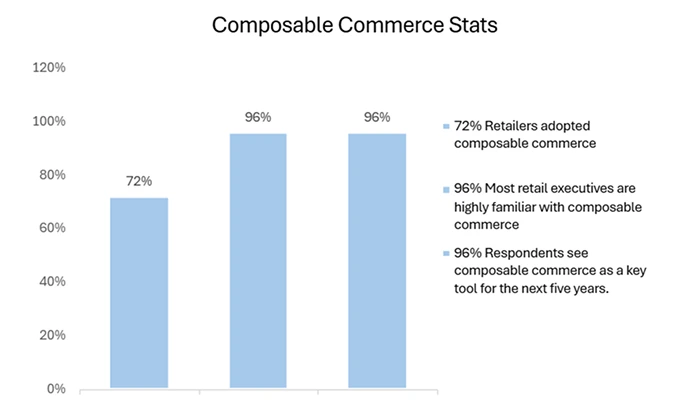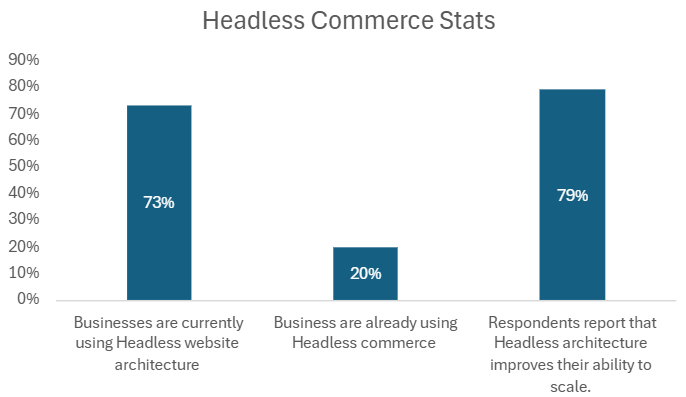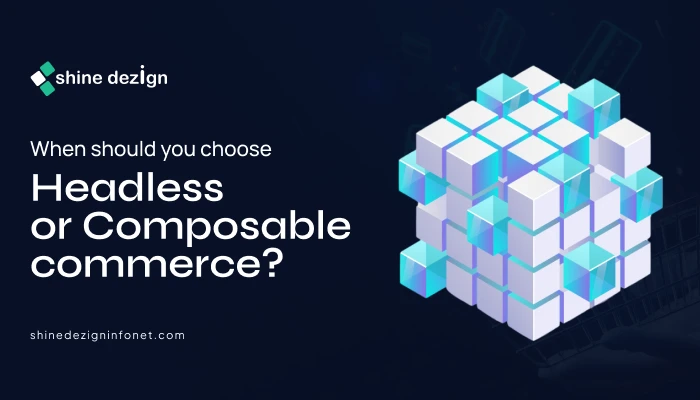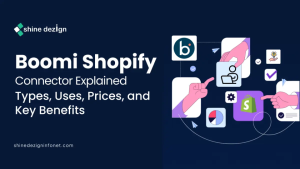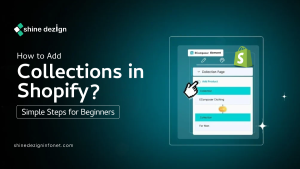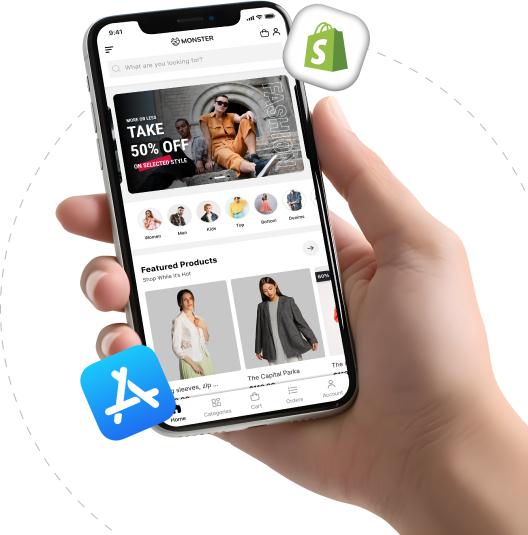Table of Contents
- Introduction
- What is Composable Commerce?
- Pros and Cons of Composable Commerce
- What is Headless Commerce?
- Pros and Cons of Headless Commerce
- Composable vs Headless Commerce: Comparison Table
- Composable vs Headless Commerce: Key Difference
- When should you choose Headless or Composable commerce?
- Compostable vs Headless Commerce: The Final Verdict
As an eCommerce business owner, you might have heard of “headless commerce” and “composable commerce.” Both allow businesses to evolve and adapt to new changes with smoother integration.
However, they have distinct concepts regarding how businesses transform and change online marketing tactics. Therefore, let’s dive into a detailed comparison of Composable Commerce vs. Headless eCommerce to understand more.
What is Composable Commerce?
Composable eCommerce is an innovative approach for developing eCommerce platforms. Instead of going with one-size-fits-all solutions, businesses can select and integrate different technologies to create a tailored solution that streamlines precisely their requirements.
In simple words, in composable commerce, different solutions are “composed” together through APIs, enabling scalability, flexibility, and personalization. For instance, if a fashion brand wants to develop a seamless online shopping experience across the web, mobile, and in-store systems, it can establish composable commerce principles instead of using a traditional monolithic eCommerce platform.
Composable commerce solutions often use the MACH framework (Microservices, API-first, Cloud-native, and Headless). These principles enable each component to communicate through APIs and function independently in the cloud. With the help of the MACH Alliance, vendors and businesses can combine best-of-breed components seamlessly.
Composable commerce Stats
As mentioned above, 72% of retailers have already adopted composable commerce in their eCommerce strategy, while 27% plan to shift and adopt a composable approach. Also, 96% of retail executives are highly familiar with Composable commerce, and 96% of respondents see it as a key tool for the next five years.
(Source: Queueit)
Pros and Cons of Composable Commerce
It is essential to have knowledge of the difference between b2b vs b2c ecommerce while strategizing. B2C ecommerce tends to be inclined towards high volumes of low-value transactions with customers, while B2B ecommerce facilitates lower, high-value bulk orders between businesses.
Pros
- Composable commerce is highly personalized and driven by client expectations, as it allows for the customization of even minor changes.
- It allows you to select your choices for the backend and front-end components.
- The MACH architecture of composable commerce supports the ability of each component to scale independently.
Cons
- Implementing composable commerce can be time-consuming. It requires time to apply and an ongoing commitment to evolve the tech stack.
- Managing all the components can be hectic, as each needs to be updated for features and security evolution.
- Setting up frontend and API resources may require technical skills.
What is Headless Commerce?
Headless Commerce describes the separation of commerce technology, separating the front-end storefronts from the functional backend of the store. This architecture offers brands freedom of expression to develop whatever and however they require to build their online store and enhance client experience. Therefore, a platform’s front and back end run independently. If changes are made in one end, they don’t affect the other.
This level of flexibility in Headless commerce allows businesses to deliver immersive commerce experiences across various factors, such as websites, mobile apps, social media, and IoT devices, and develop a complete omnichannel strategy.
Headless Commerce Stats
The Headless Commerce market was valued at $1.32 billion in 2020 and is predicted to reach $13.08 billion by 2028, reflecting a remarkable CAGR of 30.1%. Headless architecture is rapidly gaining traction, with 73% of businesses already adopting it to power their websites. In the retail sector, more than 60% of companies have plans to transition to headless commerce platforms, and over 20% have already made the shift.
Europe and North America dominate the headless commerce landscape, accounting for 63% of the global market share. Notably, 79% of businesses leveraging headless architecture report enhanced scalability, making it a strategic choice for growth-focused organizations.
(Source: crystallize)
Pros and Cons of Headless Commerce
Pros
- Promotes intelligent content creation regardless of the backend system.
- You can make changes more effortlessly and innovate without redeploying the entire architecture.
- With the pay-as-you-go model, you can easily optimize your costs depending on your budget.
Cons
- It requires technical knowledge of working with a selected backend commerce platform.
- It may require implementation and maintenance costs.
- Most of the headless solutions depend on APIs, lacking other vital features.
Composable vs Headless Commerce: Comparison Table
| Feature | Composable | Headless |
|---|---|---|
| Customization/Flexibility | Total front end and backend customization | Limited backend customization, flexible UI/UX |
| Architecture | Backend functionality is split up into modular modules. | Separates the frontend (presentation layer) from the backend. |
| Development speed | Each component can be developed, deployed and scaled independently | Development speed is faster, iterative changes to the front-end experience. |
| Ecosystem Integration | Modular components are developed and designed for easy integration. | It provides a decoupled architecture that simplifies the integration of multiple backend tools. |
| Maintenance | All components need monitoring and maintenance | Platforms manage backend updates |
| Scalability | It scales independently via different business and services models. | It scales frontend well; backend scale limited by platform. |
Composable vs Headless Commerce: Key Difference
Architecture
Composable Commerce:
Depending on modular architecture, the concept of decoupling becomes even more advanced. It breaks down the eCommerce platform into smaller, independent, specialized services, or microservices. These services can be composed together to develop personalized eCommerce solutions. Another significant benefit of composability is its impact on modularity and encouragement of selecting the best solutions for each particular function.
Headless Commerce:
This commerce decouples the front-end presentation layer, mostly a website, from the back-end eCommerce platform. This separation enables greater flexibility in delivering and designing unique client experiences. The front end also connects with the back end via APIs, allowing easy integration with different devices and channels.
Flexibility and Customization
Composable Commerce:
Composable commerce platform offers greater flexibility and personalization. It allows businesses to create an eCommerce solution by integrating and selecting specialized microservices that serve particular functions, such as payments, catalog management, order processing, and more.
Headless Commerce:
Headless commerce solutions offers flexibility by separating the frontend and backend layers. This allows businesses to create unique and tailored client experiences across different touchpoints, such as mobile apps, websites, voice assistants, or IoT devices. Developers can easily select technologies and frameworks for frontend development.
Scalability and Agility
Composable Commerce:
It includes the modularity of microservices, which boosts agility and scalability. As businesses grow or evolve, they can upgrade individual services without impacting the entire eCommerce infrastructure. This approach makes adapting to innovations and technologies or even new business marketing strategies more seamless.
Headless Commerce:
HIt allows scalability by enabling the back end to manage and handle heavy loads independently from the front end. Scaling the front end or adding new channels doesn’t impact the underlying eCommerce platform. This scalability is mainly used when handling traffic spikes during peak sales season or any other high-demand events.
Integration Strategy
Composable Commerce:
Composable commerce is developed to integrate. Every component, whether a CMS, a PIM, or a customization engine, is created and designed to communicate through APIs. Therefore, you are not just plugging tools into a single platform but building a network of best-in-class services.
Headless Commerce:
Headless platforms support integration via API, which is a good setup for older, closed systems. You can easily connect to third-party tools like analytics platforms or CMS, and most modern SaaS platforms offer developed-in apps or connectors to speed things up.
When should you choose Headless or Composable commerce?
 Choose Composable If:
Choose Composable If:
- You have teams of tech experts and system integrators.
- You are comfortable organizing and managing a more complex stack.
- It is valuable mainly for businesses that run across various regions or channels.
- You depend on complex tools and more integrations.
Choose Headless Commerce If:
- You are a growing business that needs more UX control.
- You need to personalize and get fast results.
- You operate across multiple channels.
- You prefer the best tools to integrate the best CMS, analytics, and payment tools tailored to your business.
Composable vs Headless Commerce: The Final Verdict
Headless commerce is a strong choice for businesses seeking front-end flexibility and omnichannel delivery. It’s ideal if your main goal is to create seamless, personalized experiences without rebuilding your back end.
On the other hand, compact commerce is for brands ready to take complete control. It offers unmatched agility by letting you build a custom tech stack using best-in-class tools for each function. Well, as an eCommerce store owner it’s your final choice to choose from among them. Select Headless design freedom and fast frontend innovation. You can select composable to future-proof your business with a scalable, module, and API-first approach.


